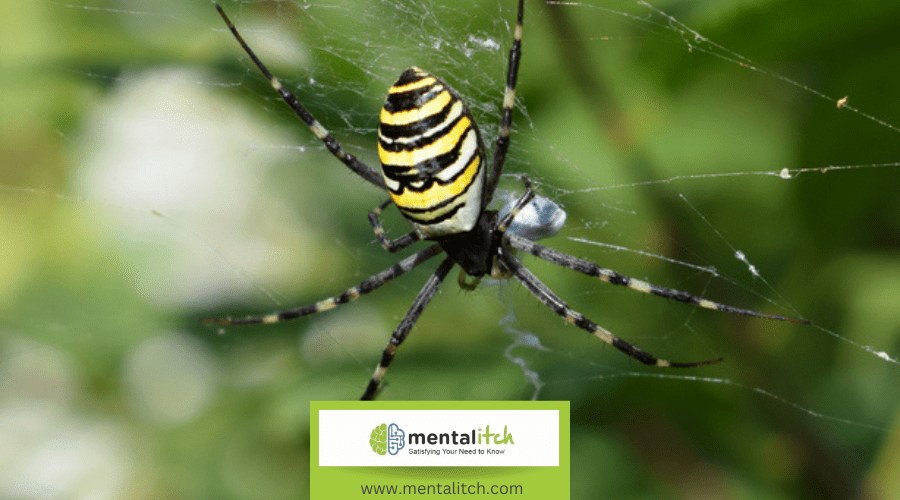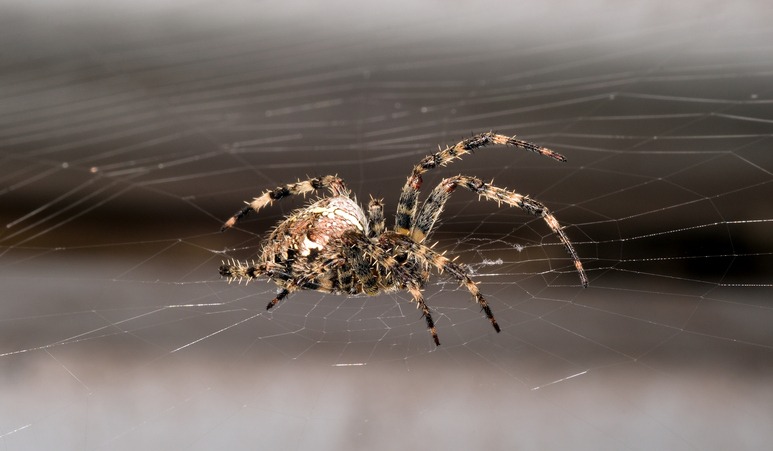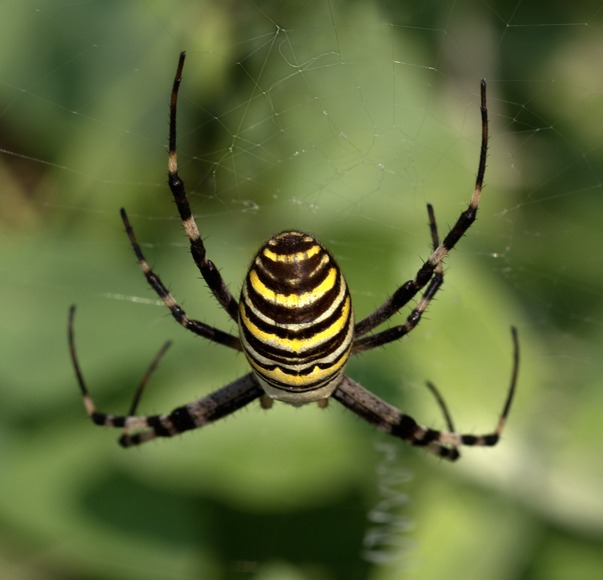This peculiar arachnid, with its vibrant colors and unique body shape, is more than just a visual marvel in your garden. Its hard, spiny abdomen, small stature, and the intricate webs it weaves play a pivotal role in the ecosystem, controlling pest populations with precision. Yet, there’s more to these creatures than meets the eye.
Let’s explore the lesser-known aspects of their life cycle, the significance of their presence in various habitats, and how they interact with their environment in a way that might just change how you view these garden guardians.
Unique Physical Characteristics
One can easily spot a spiny orb weaver by its distinct, brightly colored abdomen adorned with sharp spines. This unique feature sets it apart from other orb weavers, as its shell-like abdomen is not only a visual marvel but also serves as a deterrent to potential predators. With its body typically measuring around half an inch in length, the spiny orb weaver is a small yet fascinating creature. The females, larger than their male counterparts, showcase abdominal color variations that include pale yellow or white, highlighted by striking black or red markings. These vibrant colors and patterns make the spiny orb weaver easily recognizable among the myriad of spiders.
Belonging to the species Gasteracantha cancriformis, commonly referred to as the crab-like orbweaver or spinybacked orbweaver, this spider is a beneficial spider to have around. Its presence in your garden or backyard contributes to controlling the insect population, making it a friend rather than a foe. The combination of its distinctive physical characteristics and its role in the ecosystem underscores the spiny orb weaver’s importance and the fascination it holds for those who encounter it.
Habitat and Distribution
After exploring the spiny orb weaver’s unique physical characteristics, let’s focus on where you can find these fascinating creatures and how they’ve adapted to different environments. The spiny orb weaver, or Gasteracantha cancriformis, makes its home in a variety of settings that range from your backyard garden to woodland edges. These spiders are not just limited to natural settings; they’ve also carved out niches in urban areas, making the most of fences and other man-made structures.
Their habitat is essential as it provides them with the necessary resources to build their orb-shaped and flat webs, designed to catch a variety of pests. This not only benefits the spiny orb weaver but also contributes to natural pest control in gardens and farms. Here’s a quick overview of their habitat and distribution:
| Location | Habitat |
|---|---|
| Southern United States | Gardens, Woodland Edges |
| Central America | Urban Areas, Fences |
| Cuba | Gardens, Woodland Edges |
| Jamaica | Urban Areas, Fences |
The distribution of these spiders underlines their adaptability and the role they play in controlling pest populations. The spiny-backed orb weaver thrives in a range of environments, showcasing its versatility and importance in ecosystem balance.
Web Construction Techniques
Spiny orb weavers’ web-building skills showcase their remarkable ability to trap a wide array of flying and crawling pests efficiently. These arachnids are not just builders; they’re architects in their own right, designing traps that play an essential role in their survival and the ecosystem. Here’s how they do it:
- Size and Shape: They construct flat, orb-shaped webs that can stretch up to 10-12 inches in diameter. This sizeable architecture isn’t just for show; it’s a strategic choice to maximize their catch.
- Strategic Placement: You’ll find these webs positioned high off the ground, in places like bushes, trees, gutters, or under light sources. This isn’t random; it’s where their prey is most likely to wander.
- Efficient Design: The web construction is meticulously crafted to capture and trap both crawling and flying insects. Every strand serves a purpose, making these webs death traps for pests.
- Ecological Role: Beyond being efficient predators, spiny orb weavers play a beneficial role in controlling pest populations. Their webs are more than just homes; they’re an important part of their habitat’s health.
Diet and Hunting Behavior
Feasting on a diverse menu, spiny orb weavers skillfully ensnare a plethora of flying pests, from mosquitoes to wasps, in their ingeniously placed webs. These orb weaver spiders have honed their hunting techniques to perfection, capturing not just flying insects but also crawling ones, making them pivotal in keeping pest populations under control. They spin orb-shaped and flat webs, which can stretch up to 10-12 inches across, strategically positioning them high off the ground. You’ll find these traps set up in bushes, trees, gutters, and especially under light sources, where flying insects frequently gather.
Their diet is impressively varied, encompassing whiteflies, mosquitoes, and even the more formidable wasps. This dietary flexibility allows them to thrive in a wide range of environments and contributes significantly to natural pest management. Despite their fearsome hunting skills, spiny orb weavers are far from aggressive towards humans. Instead, they’re beneficial allies, quietly working the background to reduce the number of pests in the vicinity. Through their complex orb-shaped webs, these spiders provide a natural, chemical-free method of pest control, making them invaluable companions in your garden or any outdoor space.
Reproduction and Lifecycle
Delving into the reproduction and lifecycle of the spiny orb weaver reveals a fascinating, albeit brief, journey from egg to adulthood. Their reproductive process is both unique and fleeting, characterized by distinct stages:
- Mating Rituals: The male spiny orb weaver commences on a delicate mission to mate by tapping on the female’s web in a specific 4-beat pattern. This courtship dance is vital for successful mating.
- Creation of Egg Sacs: Post-mating, the female constructs egg sacs that house an astonishing 100-260 eggs. This egg mass is meticulously encased, safeguarding the next generation.
- Hatching: Approximately twelve days later, the eggs hatch. However, the young spiders don’t venture out immediately. They remain within the safety of the egg case for several weeks, preparing for the world outside.
- Life Cycle Completion: The lifecycle of spiny orb weavers is short and concludes dramatically with both males and females perishing shortly after their reproductive duties are fulfilled. Males die after fertilization, and females follow after laying their eggs.
Understanding this cycle sheds light on the ephemeral nature of the spiny orb weaver’s existence, underscoring the urgency and efficiency of their reproductive strategies.
Predators and Survival Strategies
Despite their prowess in capturing prey, spiny orb weavers also face threats from predators, necessitating a suite of innovative survival strategies. As a spiny orb weaver, your life isn’t just about building those intricate orb-shaped webs to trap flying insects like mosquitoes and wasps. You’re constantly on the lookout for predators that wouldn’t mind making a meal out of you.
One of your key survival strategies involves the clever use of your web. You don’t just place it anywhere; you strategically add tufts to your web to deter birds from accidentally destroying your home and posing a threat to your safety. It’s a smart move, making your web visible enough to be avoided by these potential predators.
But there’s more to your defense mechanism than just your web. Your abdomen is brightly colored, serving as a clear warning sign to any creature thinking you’d make an easy snack. This bright coloration isn’t just for show; it’s a vital part of your survival strategies, telling predators, ‘I’m not worth the trouble.’
In your world, every day is a balancing act between being a predator of pests and avoiding becoming prey yourself. Your survival strategies are not just about staying alive; they’re about thriving in a world full of threats.
Ecological Role
Through their diet of various flying insects, spiny orb weavers play an important role in managing pest populations and supporting ecosystem health. By engaging in natural pest management, these spiders contribute greatly to the well-being of our gardens and outdoor spaces. Their ability to control the populations of pests like whiteflies, mosquitoes, and wasps through their unique feeding habits is invaluable. Here’s how spiny orb weavers maintain this balance:
- Prey on a Wide Range of Insects: Including pests that are harmful to plants and humans.
- Construct Orb-Shaped Webs: These intricate structures are designed to capture flying insects effectively.
- Location of Webs: Strategically placing their webs in areas where pests are most likely to travel, such as near light sources or within vegetation.
- Non-Aggressive Nature: Their focus on insect prey makes them harmless to humans, allowing them to fulfill their ecological role undisturbed.
Understanding the ecological importance of spiny orb weavers helps in appreciating their contribution to our environment. By controlling insect populations, they play a critical part in maintaining the health and balance of ecosystems around us.
Interaction With Humans
Interacting with spiny orb weavers, you’ll find these creatures are remarkably harmless and beneficial to humans, especially in outdoor settings. These spiders, with their non-aggressive demeanor, are not known to pose any significant threat through bites, making your encounters with them in gardens, trees, and shrubs around houses worry-free. Mainly found in the southeastern United States, spiny orb weavers are a common sight in outdoor areas where they play a vital role in pest control.
By preying on flying insects such as whiteflies, mosquitoes, and wasps, these spiders prove to be beneficial allies in maintaining the balance of your garden’s ecosystem. Their presence around shrubs and in gardens is not only natural but desirable for the control of pest populations. Since spiny orb weavers rarely venture indoors, they pose little to no inconvenience to humans and instead contribute positively to our outdoor environments.
Leaving spiny orb weavers undisturbed in their natural habitats like gardens and woodlands allows them to continue their role in controlling pests, highlighting their beneficial interaction with humans. By appreciating their presence and the ecological balance they help maintain, you’re contributing to a healthier, more natural outdoor space.
Conservation Status
The spiny orb weaver spider, known scientifically as Gasteracantha cancriformis, currently faces no significant conservation threats, ensuring its stable presence across various regions. You’ll find this brightly colored spider thriving, particularly in the southern United States and other parts of North America, signifying its adaptability and resilience.
Here are some key points about its conservation status:
- Not Listed on the IUCN Red List: This indicates a lack of immediate threats to its survival, showcasing its stable condition in the wild.
- Wide Distribution: Its presence not just in North America but also in Central America, Cuba, and Jamaica speaks volumes about its adaptability to various habitats.
- Stable Population: There’s no evidence of significant population declines, ensuring its continued existence in its natural environment.
- Lack of Conservation Efforts: Given its abundance and stable population, conservationists haven’t prioritized the spiny orb weaver for specific protection measures.
Conclusion
To sum up, you’ve learned that the spiny orb weaver is not just a marvel of nature with its vibrant colors and unique shape, but it’s also an invaluable ally in your garden. By spinning intricate webs, it helps keep pest populations in check, all while being harmless to humans. Understanding its life cycle, habitat, and the ecological role it plays can deepen your appreciation for these tiny predators. So, next time you spot one, remember the essential role it’s playing in your backyard ecosystem.


